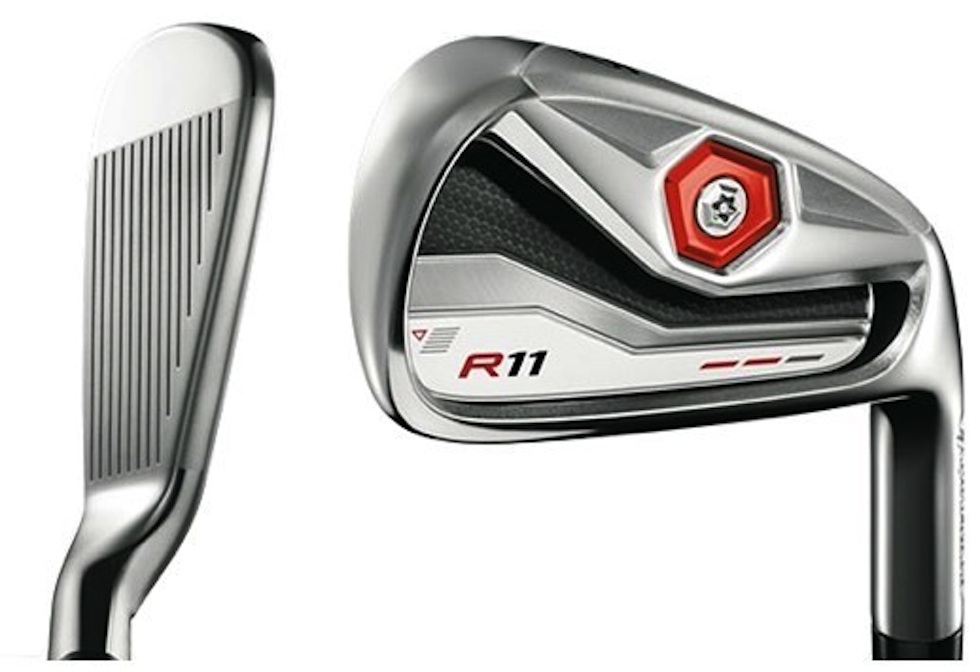 When TaylorMade introduced the R11 irons, they claimed they were the only irons worthy of the R11 name. Of course the first thing that comes to your mind when you think of R11 is the very successful white matte drivers that have blanketed golf courses lately. It is very hard these days to play in a foursome that does not have a golfer with the R11, R11s, or RocketBallz driver in their bag.
When TaylorMade introduced the R11 irons, they claimed they were the only irons worthy of the R11 name. Of course the first thing that comes to your mind when you think of R11 is the very successful white matte drivers that have blanketed golf courses lately. It is very hard these days to play in a foursome that does not have a golfer with the R11, R11s, or RocketBallz driver in their bag.
TaylorMade has been translating the technology originally targeted for woods into irons for some time now. In this seasons offering there are already both Rocketballz woods and irons, and the very popular Burner series has also had both woods and irons. R11 looks to be taking off where the R9 irons were previously placed.
The R11 irons are inspired by the R11 driver series and have integrated some of the design features of the driver into the irons. Although there is no white, there are some familiar TaylorMade trademarks in the iron head design and markings. Along with those design features TaylorMade also adds a good deal of technology into the clubs to make their performance meet the demands of many types of golfers.
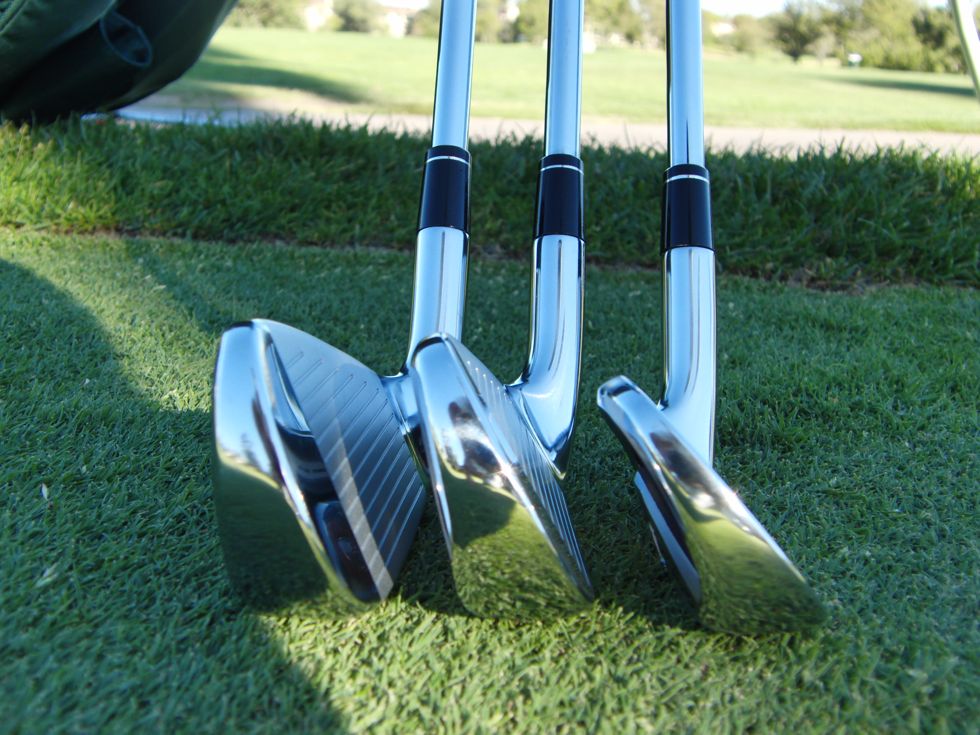
Technology
Because the R11 irons are inspired by the innovation of the R11 driver, TaylorMade claims to have created their most powerful and playable iron in their history. The first and most defining part of the iron is the red weight port, which is screwed into the back of the iron head. The visual design of the weight port is similar to the same weight port found on the R11 driver series. According to TaylorMade this weight port allows them to guarantee precise swingweights and ensure center-face center of gravity (CG) location. They claim by tuning this weight port the CG can be maximized on the center of the clubface where their competitors have weight cartridges put into the hosel moving the CG towards the heel and not in the center of the face. This leads to a larger variance after assembly and an inconsistent CG location.
As with most of the newer game improvement irons that are released today TaylorMade designed the R11 irons to have an ultra-thin face promoting faster ball speeds and longer distances especially in the long and middle irons. In addition TaylorMade has their patented Inverted Cone Technology which is designed to provide those same faster ball speeds and distance even on off-center hits. The Inverted Cone Technology is not new to the R11 irons as TaylorMade has been using this for a few generations of their irons and woods.
One additional technological feature that TaylorMade added to these irons is a Tour-inspired sole design. The designers at TaylorMade beveled the back of the sole to make it perform like a much thinner sole helping the playability from different types of lies. They were able to do this along with a low center of gravity that makes it easier to launch the ball on a powerful flight.
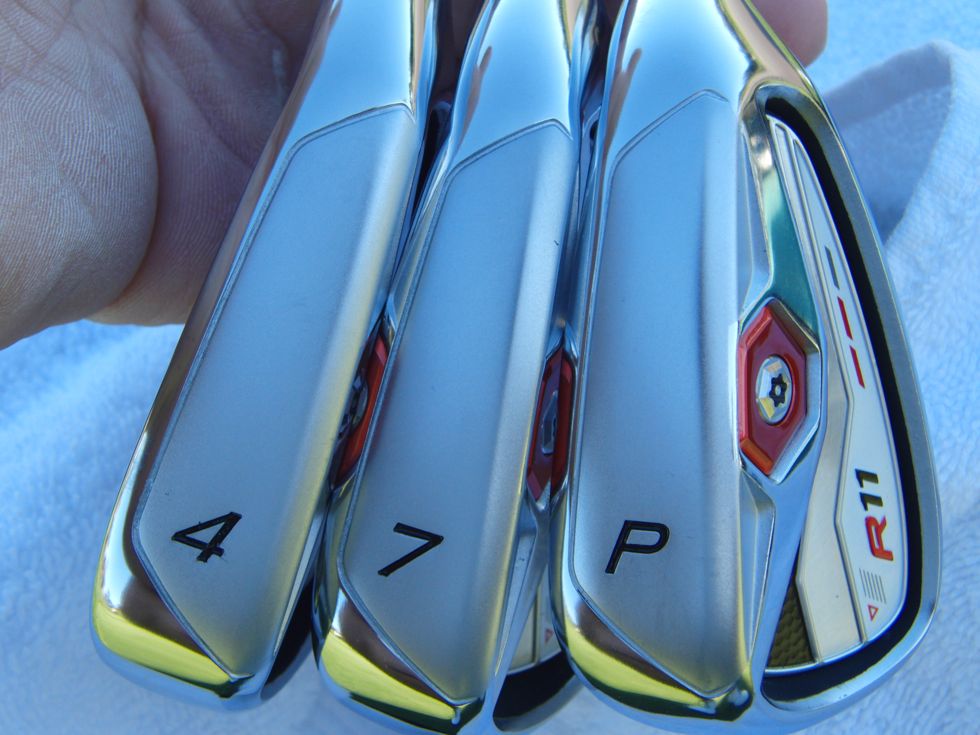
All of this outstanding technology makes the R11 iron the most innovative iron that TaylorMade has released.
Esthetics
When I first heard that TaylorMade was making the R11 irons I must admit I was thinking they would continue the white theme and carry this into the irons. I wasn’t sure how they would do this, but the design of the irons are quite traditional and are an improvement in my opinion from the R9 iron line. I felt with the R9 irons that TaylorMade was starting to approach NASCAR status with all the bright and varying colors, but the R11 is a return to traditional steel, black, and a hint of red head design.
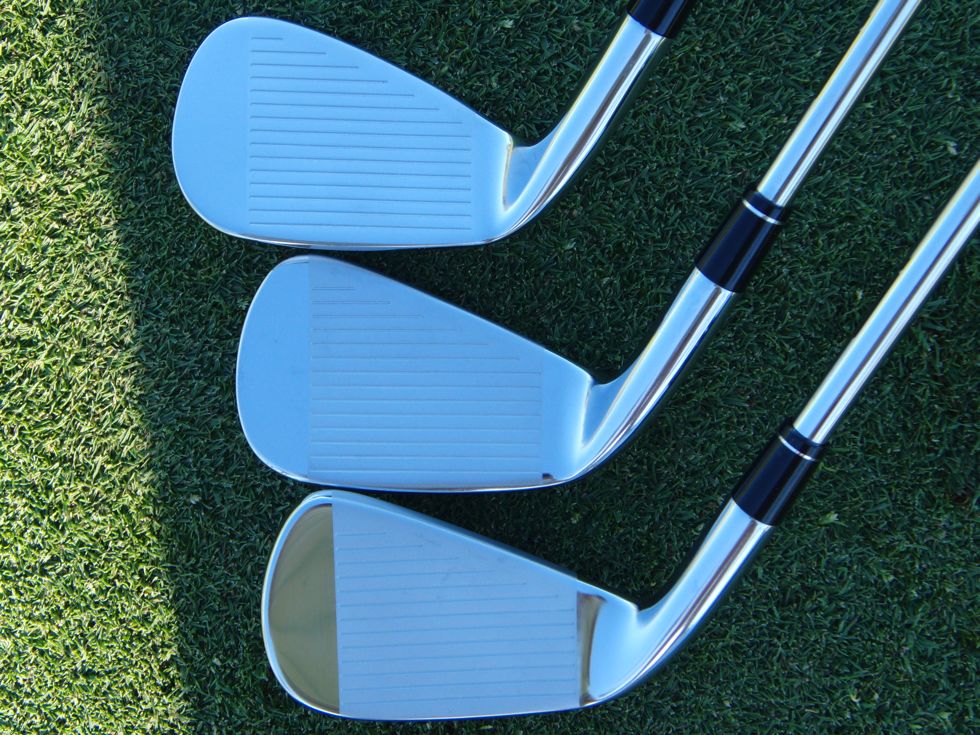
The first thing that catches your eye is red weight port. This weight port does not look adjustable as with the driver and no tools are provided along with the irons to change any weights. It is unclear to me if you could make them adjustable if the clubfitter wanted too, but there is nothing from the TaylorMade marketing department that says it is possible.
The weight port is in the middle of the back of the iron held in place by a triangular piece of metal, and a screw which is used to hold it in place. For the longer irons their is a gap between the head port and the actual face, in the lower irons there is no gap and the weight port appears to be touching directly to the face. I think that for the longer irons they are moving the CG around to allow for a higher launch.
The sole is a two-tone design with the main part being a frosted matte metallic color and the rest a shiny metallic color. The iron face is a traditional face without any features to mention. The topline of the clubhead is traditional in size for a game improvement iron and might appear a bit thick to the traditionalist. I traditionally play very thin muscle-back designs but I did not find the R11 iron topline to be overly thick.
There are some decals with the R11 identifiers in the back cavity of the iron which are a nice design feature but do not add much in the way of performance to the irons.
The 4-, 5-, and 6-irons had some noticeable offset, but in the shorter irons the offset was not as noticeable. The iron head is finished off with a traditional black ferrule and TaylorMade is etched into the hosel. The grip on my demo set was a Tour Velvet grip with a TaylorMade logo.
The irons I tested came with KBS Tour 90 shafts, which are a lighter version of the very popular KBS Tour iron shafts. I believe they went with this as the standard shaft option to offer the player a faster ball speed due to the lighter shaft. TaylorMade offers a number of the most popular shaft options, so finding what you like should not be very difficult. The irons come in both steel shafted and graphite shafted options.

Playability and Feel
Prior to playing the R11 irons I have almost exclusively used muscleback irons. This was my first try at a cavity back iron which is targeted as a mild game-improvement iron. I have to say that I was blown away at how easy these irons were to hit. Mis-hits traveled almost the same distance as well struck shots and all of the irons where very easy to hit. My set was a 4-A (specs are included below) and I found that the clubs where about a half club longer than my current set. This is likely due to the reduced loft of the irons but the length of the irons are not all that different from my current set.
It was very noticeable that the launch of the longer irons was higher than I am traditionally used too. This was a very pleasant surprise as it allowed the ball to sit on the green whereas before I had trouble stopping the longer irons on the green. The ball lands on the green with plenty of spin, I found them to spin even more than my current irons. The longer irons also have a noticeably thin face and give the club a tingy feel that you can sometimes get with fairway woods. I believe this is due to the ultra thin face but the performance of the iron, in terms ball flight, was not in anyway reduced. The long irons in this set are truly a pleasure to hit, they really put my muscle-back irons to shame. I was not able to try the 3-iron, but I believe it would be easy to hit as well.
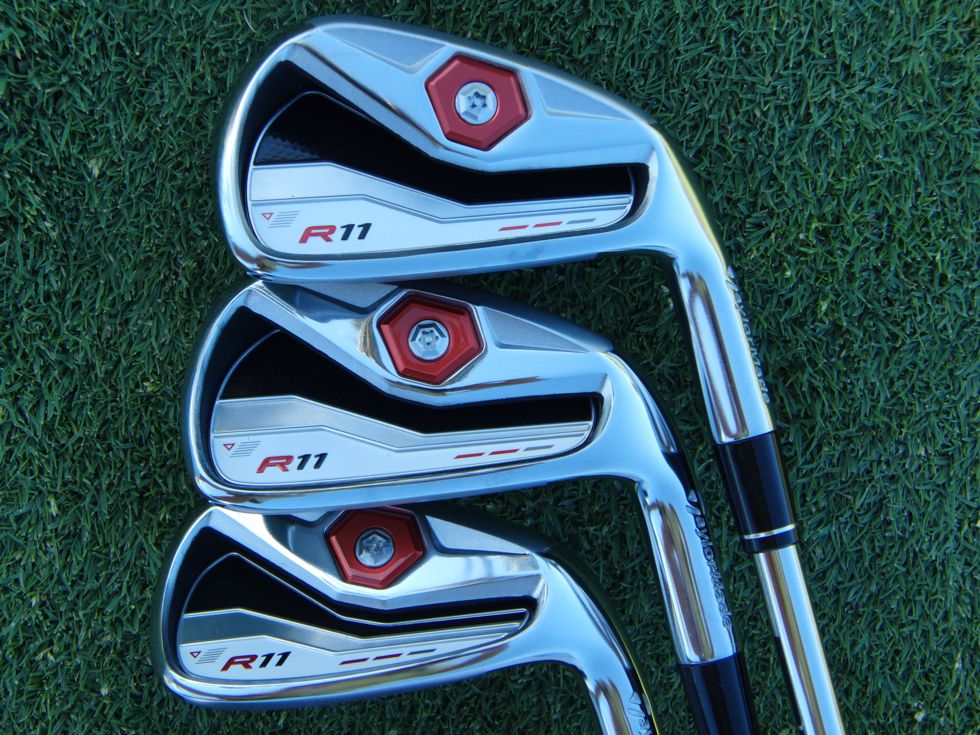
Middle irons again where about a half club longer and felt wonderful on both well struck shots as well as mishits. Middle irons have a very nice boring trajectory and do not balloon up in the air as many cavity back middle irons can do. By moving around the weight in the head of the iron they are able to better control the trajectory, which is an added bonus to the player. In many of my rounds I actually felt I could lay up on a few holes where before I felt I had to hit driver because I felt so confident over the 6 and 7 iron. Where before I typically would have dreaded that shot. These middle irons were so easy to hit it made the game quite a bit easier.
If I do have a complaint regarding the feel, it can be tough at times to determine where on the face the ball was struck. Of course extreme toe hits or heel hits could be determined but a shot hit slightly towards the heel could not be determined unless I had impact tape on the club. To some better players this may be a major turn off, but I think to the majority of the golfing population this is a minor issue. I believe that this is tradeoff that is typically made with irons that have so much forgiveness.
Specifications
Club Loft Length Lie Swing Weight ---- ---- ------ --- ------------ 4I 21° 38.25" 61.0° D2 5I 24° 37.75" 61.5° D2 6I 28° 37.25" 62.0° D2 7I 32° 36.75" 62.5° D2 8I 36° 36.25" 63.0° D2 9I 40° 35.75" 63.5° D2 PW 45° 35.5" 64.0° D2.5 AW 50° 35.5" 64.0° D2.5
Conclusion
After some initial apprehension I am very pleasantly surprised by the performance of these irons. I think TaylorMade has done an outstanding incorporating many of the technological advances they have learned with the R11 driver and put much of that into these irons. These irons will please the better players by giving them added performance and only a small tradeoff with feel, and higher handicap players will benefit from how easy they are to hit.
The irons are not unreasonably priced and fit inline with many of the other sets that are available today. TaylorMade puts a great deal of technology into the clubs they make and the R11 irons are no different. On some level I do feel that these irons a nice transition for someone like me who has used traditional muscle back designs but doesn’t get to practice as much as they used too. They make up for many of my mistakes, but still have a great feel and a somewhat traditional look.
Normally I get lost in all of the TaylorMade marketing, and I probably would never have given this set a try. I am very happy to have tried them and I am impressed with how easy they are to hit. I believe that TaylorMade has produced a winning iron that should catch the attention of middle to high handicappers when looking for something new to play. If you haven’t tried them, I would strongly suggest that you give them a try.

It is funny because the lofts on these clubs are much stronger than a standard and with longer shafts it should give flatter trajectory and a bigger distance – exactly opposite to the findings in the review, interesting – perhaps it is the KBS shaft.
First off, very true that every foursome seems to have at least one TM driver. Great review. I like the fact that the weights move closer to the face on lower clubs. Having the forgiveness of the cavity, while getting some help with the trajectory on lower clubs could really be helpful for mediocre golfers like myself.
I will say this though–the design of the weights with the screw does make it look like it could be adjustable or interchangeable. If it’s not, that could be a little misleading.
How much is a set after 2012 launching date?
Jag har spelat med med mina klubbor sen dem kom ut omgreppade så klart. Bästa klubborna någonsin. Hcp 9,9 swing it